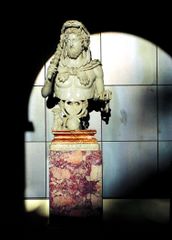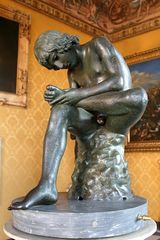متاحف الكاپيتولين
Milo Capitolini | |
 پالاتسو دي كونسرڤاتوري هو أحد المباني الثلاث الرئيسية في متاحف الكاپيتولين. | |
| تأسس | 1734 |
|---|---|
| الموقع | Piazza del Campidoglio 1, 00186 روما، إيطاليا |
| الإحداثيات | 41°53′35″N 12°28′57″E / 41.893021°N 12.4825°E |
| النوع | متحف فن وآثار وموقع تاريخي |
| المدير | Claudio Parisi Presicce |
| الموقع الإلكتروني | www |
متاحف الكاپيتولين (بالإيطالية: Musei Capitolini؛ إنگليزية: Capitoline Museums) هم متحف واحد يضم مجموعة من متاحف الفن والآثار في Piazza del Campidoglio، على قمة ربوة الكاپيتولين في روما، إيطاليا. المقار التاريخية للمتاحف هي پالاتسو دي كونسرڤاتوري و پالاتسو نوڤو ومواجهين الميدان بشكل شبه منحرف في مسقط صممه ميكلانجلو بوناروتي في 1536 ونـُفـِّذ على فترة تعدت الأربعمائة عام. تاريخ المتاحف يمكن تتبعه إلى 1471، حين تبرع الپاپا سيكستوس الرابع بمجموعة من التماثيل البرونزية القديمة الهامة إلى شعب روما ووضعهم في ربوة الكاپيتولين. ومنذ ذلك الحين، فقد نمت مقتنيات المتاحف لتضم عدداً كبيراً من التماثيل الرومانية القديمة، والنقوش والتحف الأخرى؛ ومجموعة من فنون القرون الوسطى وعصر النهضة؛ ومجموعة من المجوهرات والعملات وأشياء أخرى. المتاحف تملكها وتشغـّلها بلدية روما.
التمثال الفروسي في منتصف الميدان هو للامبراطور ماركوس أورليوس. وهو نسخة، العمل الأصلي محفوظ داخل متحف الكاپيتولين.
ولأن متاحف الكاپيتولين افتتحت للعامة سنة 1734 في عهد الپاپا كلمنت السابع، لذلك فهي تعتبر أول متحف في العالم، مفهوم أنه مكان للاستمتاع بالفنون للجميع وليس فقط لمالكيه.[1]
. . . . . . . . . . . . . . . . . . . . . . . . . . . . . . . . . . . . . . . . . . . . . . . . . . . . . . . . . . . . . . . . . . . . . . . . . . . . . . . . . . . . . . . . . . . . . . . . . . . . . . . . . . . . . . . . . . . . . . . . . . . . . . . . . . . . . . . . . . . . . . . . . . . . . . . . . . . . . . . . . . . . . . . .
المباني
هذا القسم يحتوي مجموعات مرتبة حسب المبنى، ومعلومات وجيزة حول المباني نفسها. لتاريخ تصميمهم وإنشائهم، انظر ربوة الكاپيتولين#ميكلانجلو.
The Capitoline Museums are composed of three main buildings surrounding the Piazza del Campidoglio and interlinked by an underground gallery beneath the piazza.
المباني الثلاث الرئيسية في متاحف الكاپيتولين هي:
- پالاتسو سناتوريو، built in the 12th century and modified according to Michelangelo's designs;
- پالاتسو دي كونسرڤاتوري، built in the mid-16th century and redesigned by Michelangelo with the first use of the giant order column design; and
- پالاتسو نوڤو، built in the 17th century with an identical exterior design to the Palazzo dei Conservatori, which it faces across the palazzo.
In addition, the 16th century Palazzo Caffarelli-Clementino, located off the piazza adjacent to the Palazzo dei Conservatori, was added to the museum complex in the early 20th century.
پالاتسو دي كونسرڤاتوري
المجموعة هنا تتكون من تماثيل قديمة، معظمها روماني ولكن أيضاً من اليونان ومصر القديمتين.
السلم الرئيسي
Features the relief from the honorary monument to ماركوس أورليوس.
الدور الثاني
The second floor of the building is occupied by the Conservator's Apartment, a space now open to the public and housing such famous works as the bronze she-wolf nursing Romulus and Remus, which has become the emblem of Rome. The Conservator's Apartment is distinguished by elaborate interior decorations, including frescoes, stuccos, tapestries, and carved ceilings and doors.
الدور الثالث
The third floor of the Palazzo dei Conservatori houses the Capitoline Art Gallery, housing the museums' painting and applied art galleries. The Capitoline Coin Cabinet, containing collections of coins, medals, jewels, and jewelry, is located in the attached Palazzo Caffarelli-Clementino.
پالاتسو نوڤو
Statues, inscriptions, sarcophagi, busts, mosaics, and other ancient Roman artifacts تشغل دورين في پالاتسو نوڤو.
في قاعة الگالاتيين يمكن مشاهدة التمثال الرخامي "الغالي المحتضر" يسمى أيضاً “غالي الكاپيتولين” وتمثال Cupid and Psyche. Also housed in this building are:
- The colossal statue restored as Oceanus, located in the museum courtyard of this building
- A fragment of the Tabula Iliaca تقع في قاعة الحمائم
- تمثال ڤينوس الكاپيتولين، عن أصل نحته پراكسيتليز (القرن الرابع ق.م.)
Galleria Congiunzione
The Galleria Congiunzione is located beneath the Palazzo dei Conservatori and the piazza itself, and links the three palazzos sitting on the piazza. The gallery was constructed in the 1930s. It contains in situ 2nd century ruins of ancient Roman dwellings, and also houses the Galleria Lapidaria, which displays the Museums' collection of epigraphs.
الجناح الجديد
The new great glass covered hall — the Sala Marco Aurelio — created by covering the Giardino Romano is similar to the one used for the الصالة المثمنة و الفناء الكبير للمتحف البريطاني. The design is by the architect Carlo Aymonino. Its volume recalls that of the oval space designed by Michelangelo for the piazza.
Its centerpiece is the bronze equestrian statue of Marcus Aurelius, which was once in the centre of Piazza del Campidoglio and has been kept indoors ever since its modern restoration. Moving these statues out of the palazzo allows those sculptures temporarily moved to the سنترالى مونتىمارتيني to be brought back. It also houses the remaining fragments of the bronze Colossus of Constantine and the archaeological remains of the tuff foundations of the temple of Capitoline Jupiter, with a model, drawn and computer reconstructions and finds dating from the earliest occupation on the site (في منتصف العصر البرونزي: القرون 17-14 ق.م.) إلى تأسيس الهيكل (القرن السادس ق.م.).
وفي القاعات الثلاث المجاورة لـ Appartamento dei Conservatori توجد معارض لمجموعة كاستلاني الشهيرة التي تضم كجزء منها مزهريات يونانية وإتروسكية تبرع بها لبلدية روما أوگوستو كاستلاني في منتصف القرن التاسع عشر.
سنترالى مونتىمارتيني
السنترالى مونتىمارتيني[2] is a former power station of Acea (active as a power-station between the 1890s and 1930s) in southern Rome, between Piramide and the basilica of San Paolo Fuori le Mura, close to the Metro station Garbatella. In 1997, the Centrale Montemartini was adapted to temporarily accommodate a part of the antique sculpture collection of the Capitoline museums, at that time closed for renovation; the temporary exhibition was so appreciated that the venue was eventually converted into a permanent museum. [3] Its permanent collection comprises 400 ancient statues, moved here during the reorganisation of the Capitoline Museums in 1997, along with tombs, busts, and mosaics. Many of them were excavated in the ancient Roman horti (e.g. the Gardens of Sallust) between the 1890s and 1930s, a fruitful period for Roman archaeology. They are displayed there along the lines of Tate Modern, except that (unlike there) the machinery has not been moved out.
معرض صور
الأمازون الجريحة، نسخة من عمل أصلي لـفيدياس
نسخة محتملة من تمثال أرتميس، من نحت كفيسودوتوس.
تمثال نصفي لأغسطس
تمثال نصفي لكليوپاترا، سنترالى مونتىمارتيني، روما
قسطنطين الأول، ربما كان أصلاً من بازيليكا ماكسنتيوس
إروس الكاپيتوليني
Dancing Maenad
تمثال فروسي لـماركوس أورليوس
تمثال أثينا، سنترالى مونتىمارتيني، روما
ذئبة روما
فناء متحف الكاپيتولين
تمثال نصفي "سيدة فلاڤية"، في متاحف الكاپيتولين، روما.
انظر أيضاً
الهامش
- ^ AA. VV. Roma e dintorni, edito dal T.C.I. nel 1977, pag. 83. ISBN 88-365-0016-1. Sandra Pinto, in Roma, edito dal gruppo editoriale L'Espresso su licenza del T.C.I. nel 2004, pag. 443. ISBN 88-365-0016-1. AA. VV. La nuova enciclopedia dell'arte Garzanti, Garzanti editore, 2000, ISBN 88-11-50439-2, alla voce "museo".
- ^ Centrale Montemartini Archived أكتوبر 5, 2006 at the Wayback Machine
- ^ "Centrale Montemartini". Inexhibit magazine. Retrieved March 7, 2016.
وصلات خارجية
- Capitoline Museums official website (English language version). Retrieved April 26, 2010.
- Capitoline Museums research website (English/German/Italian language versions).
قالب:Rome museums خطأ لوا في package.lua على السطر 80: module 'Module:Authority control/auxiliary' not found.
- Pages using gadget WikiMiniAtlas
- Pages using infobox museum with unsupported parameters
- Articles containing إنگليزية-language text
- Pages using Lang-xx templates
- Art museums and galleries in Rome
- ميادين روما
- متاحف أثرية في إيطاليا
- Museum districts
- تأسيسات 1471 في إيطاليا
- متاحف روما القديمة في إيطاليا
- متاحف اليونان القديمة
- متاحف عملات
- متاحف تأسست في 1471
- متاحف الكاپيتولين
- مقالات تحتوي مقاطع ڤيديو
- Rome R. X Campitelli
- Rome Q. X Ostiense



































